

Johannes Kepler. Johannes Kepler (German: [ˈkʰɛplɐ]; December 27, 1571 – November 15, 1630) was a German mathematician, astronomer, and astrologer.

A key figure in the 17th century scientific revolution, he is best known for his laws of planetary motion, based on his works Astronomia nova, Harmonices Mundi, and Epitome of Copernican Astronomy. These works also provided one of the foundations for Isaac Newton's theory of universal gravitation. During his career, Kepler was a mathematics teacher at a seminary school in Graz, Austria, where he became an associate of Prince Hans Ulrich von Eggenberg.
Later he became an assistant to astronomer Tycho Brahe, and eventually the imperial mathematician to Emperor Rudolf II and his two successors Matthias and Ferdinand II. He was also a mathematics teacher in Linz, Austria, and an adviser to General Wallenstein. Early years[edit] Simon Marius. In 1614 Marius published his work Mundus Iovialis describing the planet Jupiter and its moons.

Here he claimed to have discovered the planet's four major moons some days before Galileo Galilei. This led to a dispute with Galileo, who showed that Marius provided only one observation as early as Galileo's, and it matched Galileo's diagram for the same date, as published in 1610. It is considered possible that Marius discovered the moons independently, but at least some days later than Galileo. David Fabricius. David Fabricius David Fabricius (March 9, 1564 – May 7, 1617), was a German theologian who made two major discoveries in the early days of telescopic astronomy, jointly with his eldest son, Johannes Fabricius (1587–1615).
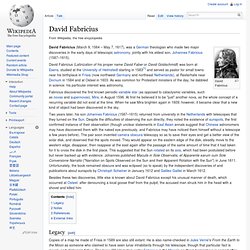
David Fabricius (Latinization of his proper name David Faber or David Goldschmidt) was born at Esens, studied at the University of Helmstedt starting in 1583[1] and served as pastor for small towns near his birthplace in Frisia (now northwest Germany and northeast Netherlands), at Resterhafe near Dornum in 1584 and at Osteel in 1603. As was common for Protestant ministers of the day, he dabbled in science: his particular interest was astronomy. Godefroy Wendelin. Nicolaus Copernicus. Nicolaus Copernicus. 1.
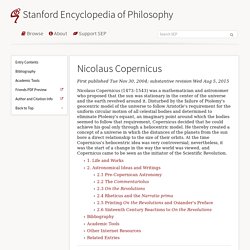
Life and Works. Science Photo Library. De revolutionibus orbium coelestium. The text of: Nicholas Copernicus De Revolutionibus (On the Revolutions), 1543 C.E.

Nicholas Copemicus (1473-1543) That Nicholas Copernicus delayed until near death to publish De revolutionibus has been taken as a sign that he was well aware of the possible furor his work might incite; certainly his preface to Pope Paul III anticipates many of the objections it raised. But he could hardly have anticipated that he would eventually become one of the most famous people of all time on the basis of a book that comparatively few have actually read (and fewer still understood) in the 450 years since it was first printed. Copernicus was bom into a well-to-do mercantile family in 1473, at Torun, Poland. Heliocentrism. Andreas Cellarius's illustration of the Copernican system, from the Harmonia Macrocosmica (1660).
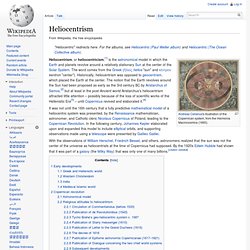
Heliocentrism, or heliocentricism,[1] is the astronomical model in which the Earth and planets revolve around a relatively stationary Sun at the center of the Solar System. The word comes from the Greek (ἥλιος helios "sun" and κέντρον kentron "center"). The Heliocentric Theory of Nicolaus Copernicus.
Considered one of the most significant astronomical thinkers of all time, Nicolaus Copernicus forever changed the way scientists understand the design of our solar system.
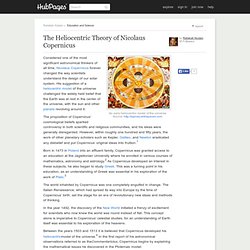
Erasmus Reinhold. Erasmus Reinhold (October 22, 1511 – February 19, 1553) was a German astronomer and mathematician, considered to be the most influential astronomical pedagogue of his generation.[1] He was born and died in Saalfeld, Saxony.

He was educated, under Jacob Milich, at the University of Wittenberg, where he was first elected dean and later became rector. In 1536 he was appointed professor of higher mathematics by Philipp Melanchthon. Prutenic Tables. The Prutenic Tables (Latin: Tabulae prutenicae from Prutenia meaning "Prussia", German: Prutenische oder Preußische Tafeln), were an ephemeris (astronomical tables) by the astronomer Erasmus Reinhold published in 1551.
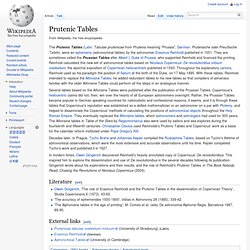
They are sometimes called the Prussian Tables after Albert I, Duke of Prussia, who supported Reinhold and financed the printing. Reinhold calculated this new set of astronomical tables based on Nicolaus Copernicus' De revolutionibus orbium coelestium, the epochal exposition of Copernican heliocentrism published in 1543. Throughout his explanatory canons, Reinhold used as his paradigm the position of Saturn at the birth of the Duke, on 17 May 1490. With these tables, Reinhold intended to replace the Alfonsine Tables; he added redundant tables to his new tables so that compilers of almanacs familiar with the older Alfonsine Tables could perform all the steps in an analogous manner. Literature[edit] External links[edit]
Tycho Brahe. Tycho Brahe listen (14 December 1546 – 24 October 1601), born Tyge Ottesen Brahe,[1][2][3][4] was a Danish nobleman known for his accurate and comprehensive astronomical and planetary observations.
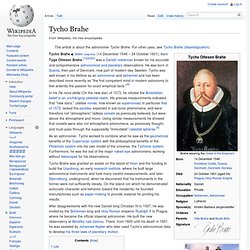
He was born in Scania, then part of Denmark, now part of modern-day Sweden. Tycho was well known in his lifetime as an astronomer and alchemist and has been described more recently as "the first competent mind in modern astronomy to feel ardently the passion for exact empirical facts. "[5] Tychonic system. In this depiction of the Tychonic system, the objects on blue orbits (the moon and the sun) rotate around the earth. The objects on orange orbits (Mercury, Venus, Mars, Jupiter, and Saturn) rotate around the sun.
Around all is a sphere of stars, which rotates. Tychonic system The Tychonic system (or Tychonian system) was a model of the solar system published by Tycho Brahe in the late 16th century which combined what he saw as the mathematical benefits of the Copernican system with the philosophical and "physical" benefits of the Ptolemaic system. The model may have been inspired by Valentin Naboth[1] and Paul Wittich, a Silesian mathematician and astronomer.[2] A similar geoheliocentric model was also earlier proposed by Nilakantha Somayaji of the Kerala school of astronomy and mathematics.[3][4] Operum primitias De nova stella. Summi civis memor denuo edidit Regia Societas Scientiarium Danica. Insunt effigies et manus specimen Tychonis.
SN 1572. Historic description[edit] Thomas Digges. Thomas Digges (c.1546 – 24 August 1595) was an English mathematician and astronomer. He was the first to expound the Copernican system in English but discarded the notion of a fixed shell of immoveable stars to postulate infinitely many stars at varying distances;[1] he was also first to postulate the "dark night sky paradox".[2] Life[edit] Digges died 24 August 1595.
Giordano Bruno. Giordano Bruno (Latin: Iordanus Brunus Nolanus; Italian: [dʒorˈdano ˈbruno]; 1548 – February 17, 1600), born Filippo Bruno, was an Italian Dominican friar, philosopher, mathematician, poet, and astrologer.[3] He is celebrated for his cosmological theories, which went even further than the then-novel Copernican model: while supporting heliocentrism, Bruno also correctly proposed that the Sun was just another star moving in space, and claimed as well that the universe contained an infinite number of inhabited worlds, identified as planets orbiting other stars. He was noteworthy in the 16th Century for promoting a pantheistic conception of God, to the dismay of the Catholic Church.[4] In addition to his cosmological writings, Bruno also wrote extensively on the art of memory, a loosely organized group of mnemonic techniques and principles.
Life[edit] De Imenso, De Minimo andDe Infinito. Giordano bruno. Picatrix: Ghayat Al-Hakim Picatrix Volume Two contains the 3rd and 4th books of Ghayat Al-Hakim and will complete the English translation. It is a larger book than volume one and contains much in the way of the practical working of astral and talismanic magic. Giordano Bruno Trials (1592 & 1600): Selected Links. "Innumerable suns exist; innumerable earths revolve around these suns in a manner similar to the way the seven planets revolve around our sun.
Living beings inhabit these worlds. " Michael Servetus. Chapter%2014_4-the_trial_of_michael_servetus. Thomas Harriot. Admiranda narratio fida tamen, de commodis et incolarvm ritibvs Virginiæ : nvper admodvm ab Anglis, qvi à Dn. Richardo Greinvile equestris ordinis viro eò in coloniam anno M.D. LXXXV. dedvcti svnt inventæ, svmtus faciente Dn. VValtero Raleigh equestris or. The Galileo Project. Thomas harriot moon drawing - Google meklēšana. Galileo Galilei. Galileo Galilei (Italian pronunciation: [ɡaliˈlɛːo ɡaliˈlɛi]; 15 February 1564[3] – 8 January 1642), often known mononymously as Galileo, was an Italian physicist, mathematician, engineer, astronomer, and philosopher who played a major role in the scientific revolution during the Renaissance. His achievements include improvements to the telescope and consequent astronomical observations and support for Copernicanism.
The Galileo Project. I dialoghi di Galileo Galilei sui massimi sistemi tolemaico e copernicano : volume unico. Dialogues concerning two new sciences. The private life of Galileo. Le operazioni del compasso geometrico e militare. Galileo e l'Inquisizione : documenti del processo Galileiano esistenti nell'Archivio del S. Uffizio e nell'Archivio segreto vaticano. Dal carteggio e dai documenti, pagine di vita di Galileo. Frammenti e lettere. Galileo Galilei e la sua scuola, letture scelte e annotate ad uso delle RR. Prosa; oer saggi criticamente disposti ad uso scolastico e di cultura da I. del Lungo e A. Favaro. Opere di Galileo Galilei nobile fiorentino. The Archimedes Project. Pierre Gassendi.